► CAR’s hardcore sports car test
► Porsche vs McLaren vs Lambo
► Which distilled version is best?
Four-wheel drive and rear-wheel drive; mid-
engined and rear-engined; naturally-aspirated and turbocharged; £141,000, £185,000 and £215,000. Rarely does a CAR Giant Test contain three cars so different in the way they go about their business. The common ground, the musketeers’ hand pile-on, the weird bit at the middle of a Venn diagram, is the exact nature of that business. It’s not simply going fast. Any supercar can do that. These cars are only one tiny step removed from the racetrack, and as perfectly at home on it as they are parked at a Cars and Coffee meet serving as a handy armrest while you regale onlookers with tales of track heroics.
From tall stories to long tails, specifically the McLaren 600LT, the latest track-tuned supercar vying for your lottery lolly. Neither McLaren’s model naming strategy nor its styling is helpful for beginners, and even clued-in car fans have to think twice to be sure about what the new model is. So, to be clear, the 600LT is part of McLaren’s entry-level Sports Series range that until now consisted of the 540C, 570S and fastback 570GT. Like those cars the three-character number refers to the ouput in metric horsepower, meaning the 600LT has 600ps, or 592bhp, from its 3.8-litre twin-turbo V8.
The LT bit, meanwhile, riffs on the elongated versions of the McLaren F1 road-car-turned-racer campaigned at Le Mans in the late ’90s rather than any colossal increase in actual length (the 600 does measure 75mm longer than the 570S, but the credit for that gain is split front and rear). The name’s first appearance in the modern era was on the 675LT, a lighter, harder, faster and plain brilliant offshoot of the 650S.
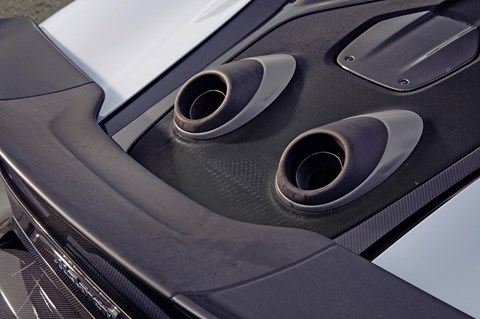
In its lightest configuration, with all trick options selected, the 1356kg 600LT weighs 100kg less than an ordinary 570S. To go with the lighter weight there’s 100kg more push from aero aids, including a jutting front lip and a fixed rear spoiler whose centre section is covered in a special material to protect it from flames that shoot from twin pipes poking clear of the rear deck. Actually, other supercars shoot flames too, but we can’t remember seeing them in the rear-view mirror before. Shall we just call it for the McLaren and wrap it up here?
At £185,500, the 600LT finds itself in clean air between the £149k 570S that spawned it and the bigger, faster, but supposedly conceptually less focused £209k 720S from the rung above. And at that price it looks like strong value next to the £215,000 Lamborghini Huracan Performante.
Unlike McLaren, Lambo uses a different tag for the hardest of its cars: SV or Super Veloce for the V12 Aventador, and Performante for the V10 Huracan. The recipe is the same, though. More power, 631bhp to be precise from a naturally-aspirated 5.2 V10, less weight, and sufficient overall performance capability to carve its name on the Nordschleife leader board. Back in 2017 the Performante was briefly the overall ‘Ring champ, having snatched the title from the Porsche 918 hypercar with a time of 6min 52.01sec, though Porsche’s 911 GT2 RS and Lamborghini’s own Aventador SVJ have both gone substantially quicker since.
For the record – but not fast enough to capture it – the GT2’s little brother, the £141,346 GT3 RS that we’re testing, rounds the ‘Ring in 6min 56.40sec. Or at least it does if you have nuts made of titanium. Like the 2RS, the 3 comes with race-spec rose-jointed suspension, air-hungry NACA ducts sunk into the bonnet and a wing like a picnic table, and it sends its power exclusively to the rear wheels through a seven-speed dual-clutch transmission. You can have a six-speed manual on the plain GT3 (it’s mandatory on the GT3 Touring), but the RS is PDK-only. Unlike its 692bhp GT2 RS big brother, however, the GT3 RS is a turbo-free zone. Its 4.0 naturally-aspirated flat-six is good for a comparatively modest-sounding 513bhp, but promises more noise and a cleaner throttle response as compensation.
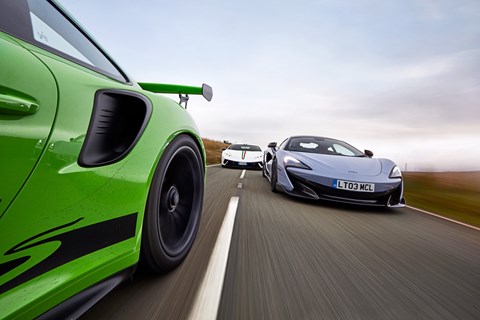
Despite the aero garnish, it’s still shaped like a 911, which, for some people, is a tick bigger than the one on the side of an4
ogre’s Air Jordans. A chap on a BMW S1000RR superbike,
the two-wheel equivalent of this trio, stops for a gander, casts an eye over the three cars and declares: ‘It’s got to be the 911, hasn’t it? The other two are just footballers’ cars.’
But for another equally fanatical tribe, those same-again looks mean that, even with all the wings and the oversized wheels with their gorgeous centre-lock hubs stuffed so far into the arches it looks like it’s on custom-scene airbags instead of boring old steel coils, the RS simply doesn’t look enough like a supercar. It looks like a better version of a nice £80k Carrera.
Supercar or not?
‘That,’ they’ll say, motioning to the Lamborghini, shaped like a stunt ramp and rumbling so menacingly that if Lambo did a TV advert it’d be banned before the watershed, ‘is what a supercar looks like.’ Climb inside and the view through the impossibly raked windscreen is exactly how you imagined it would be in a Countach or Diablo (delete as applicable) when you were young. The base of the screen is so far away you’d need one of those litter-picker claws to reach a pay-and-display ticket blown to the far side of the dash. There’s an almost square steering wheel, a configurable TFT instrument cluster and hexagons everywhere. It’s like the inside of a goth beehive.
It feels suitably supercar-y, though your 11-year-old self would be disappointed that the doors don’t scissor upwards (that’s reserved for the V12 Aventador). Your current self is more likely to be concerned by the lack of headroom. As in all Huracans, the seat on this one is mounted too high.
McLaren’s 600LT satisfies your young and present selves. Slide a hand along the underside of the side blade that seems to float proud of the body structure, push the release and the door lifts smoothly. Woking doesn’t reserve the good stuff for its richest customers. Whether you’re buying a £135k 540C starter supercar or a £2m central-seat Speedtail, you get great doors. LT buyers get a version of the same V8 and a fancy carbon chassis, too, albeit one made from pre-preg carbon rather than the fancy time-consuming hand-laid stuff. And you get a driving position that feels like it was actually designed with the help of a human rather than from a picture of one in an encyclopaedia, plus the option of the very sexy looking carbon chairs lifted from the Senna.
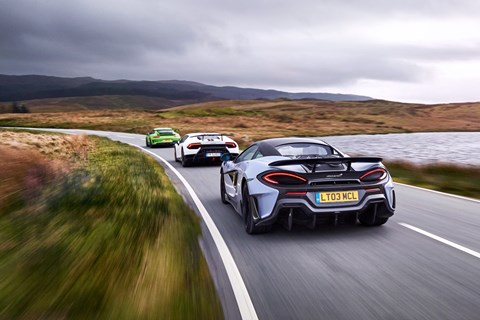
You’ll be needing a comfy seat when we tell you those chairs are part of a £24,200 MSO (McLaren Special Operations) Clubsport Pack that’s basically a load of non-essential carbon trinkets. Terrifyingly, that pack contributed to less than half of the £60k of options on our car (ironically, this same car did without either air conditioning or a radio in the name of lightness) that pushed its price close to a scary quarter of a million quid, or right into 720S-with-options territory. Food for thought.
For all its carbon trim pieces and £2990 McLaren Designer Interior, the cabin feels more like something Lotus would put in a second-gen Evora if it actually got its act together. It’s not that the quality is poor (though we did have the too-usual ‘key-not present’ message pop up when it clearly was). Perhaps it’s that there’s so little going on in there it feels a bit plain. Just a small instrument binnacle, compact vertical media screen and not4 much else. There’s no glovebox and the ergonomics aren’t great: the optional nose lift kit to haul the new, longer, lower front end clear of steeply angled drives should be operated by a dedicated button on the console, but instead you have to wade through some sub-menus using a column stalk.
The Wales handling test
Maybe McLaren’s engineers keep meaning to flag it up for a fix, but then they drive the car and it’s so damn good they forget all about it. The 600LT is an absolute masterclass in how to make a sports car ride and handle. At 1356kg this is the lightest car here, 124kg lighter than the Lambo and 74kg lighter than the Porsche. It feels it. You flick the 600LT around like a Lotus Elise, connected to the front tyres by steering that’s arguably the stand-out feature of the whole car. Hey, it might just be the stand-out feature of any car.
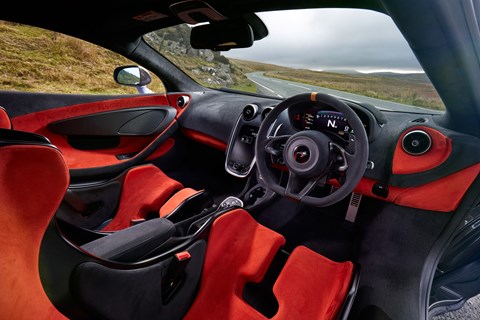
McLaren says the rack is three per cent faster than the 570S’s, though it’s not the extra speed you notice, more the extra clarity in the messages relayed to your hands. It’s light in your fingertips, and busy too, not to the extent that it sniffs out ruts and grooves like the Senna, but definitely busy. Drive it quickly and you’ll need to pay attention.
You feel the LT’s extra body control compared with the 570S, but the suspension – conventional steel-sprung rather than hydraulic, like the bigger 720S – never feels harsh, even after you’ve upped the suspension’s defcon level from Normal to Sport. Track mode best left for the track. Funny, that.
The Lambo’s not so easy to gel with. There’s that strange driving position and inferior visibility to knock your confidence. And where the McLaren’s steering feels so effortlessly natural, Sant’Agata’s engineers seem to have got sucked into following their cross-town rivals Ferrari into fitting a hyper-quick rack. You don’t have that immediate confidence. Not that it won’t stick exactly – you’re just less sure how things will pan out.
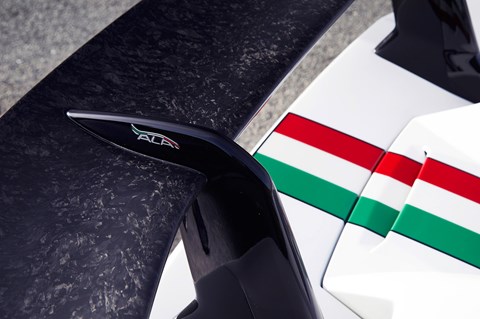
Get out of the Performante now and you might dismiss it as a footballers’ car, just like our biker. But keep driving and you realise it’s so much better than that. There’s an incredible amount of front-end bite, for a start. And once your brain attunes to the way the steering responds, you start to trust yourself and the car to use it. There’s not quite the same level of connection you get with the McLaren, but the Performante feels hyper alert, and the fact that all four P-Zero-wrapped 20-inch rims are helping out makes the Huracan feel most secure under power.
Flicking the Anima switch on the steering wheel changes the torque split and also the steering effort, damping and gearshift map. Strada slurs through the gears just fine for the Knightsbridge GP, but Corsa is best saved for the track, and even then only when you want to extract the quickest possible time. Sport’s more rear-biased torque split makes it most fun.
But not as much fun as the GT3 RS. Pushed to call it, we’d say the McLaren’s steering shades the Porsche’s for driver involvement at all speeds, not only when you’re working the rubber. But the GT3’s is right up there with the best. And as with its 911 Turbo brother, the RS steers from both ends. The four-wheel steering tech on the back axle is a brilliantly integrated system. The only time it feels obvious is at parking speeds where it helps turn the car in spaces tight enough to make a supermini feel supersized. In every other situation it shifts almost imperceptibly between steering with and against the front wheels. Go over-ambitiously hard and the lack of front-end weight manifests itself in a whiff of understeer. But through the quick stuff it’s absolutely locked down.
Get your motor running
Compared with the old GT3 RS, the spring rates are massive: doubled at the front and 50 per cent stiffer at the back. The body control is impeccable but the PASM adaptive dampers’ stiffer mode can make a really tough British B-road feel choppier than the Cape of Good Hope in a gale, and the rose-jointed suspension that helps make the steering feel so special also makes running over a cat’s eye feel like you’ve run over the rest of the cat too.

Work the flat-six through the last 1000rpm to the epic 9000rpm redline and you might wonder whether that cat got caught in the drivebelt on the way under. Between 8000 and 9000rpm the 4.0 makes the best noise of any production car on the planet. But it’s a rarefied treat. The PDK box disguises the six’s modest 347lb ft of torque by dropping gears at the lightest brush of right pedal, keeping the engine working, and moving you so fast that you’ll normally run into traffic before you unlock the best bit. Given everything, the RS will hit 62mph in 3.2sec, but we really do mean everything. The engine responds crisply from low revs but little happens below 5000rpm.
But if you’re of a lazier disposition the Lambo pulls harder from low revs thanks to its extra 1200cc, and the combination of four-wheel drive and an extra 118bhp helps it chip 0.3sec from the 911’s 0-62mph time. It’s the Performante’s V10 that defines the car. It sounds raw and urgent and a little intimidating from the moment you poke your finger through the gimmicky flap
to reach the starter button to the moment you reach out to grab the gorgeous forged carbon shift paddles. It sounds even better than the Porsche through much of the rev range, and matches the GT3 RS’s turbo-free throttle response.
McLaren 600LT vs Huracan Performante vs Porsche 911 GT3 RS: verdict
And it’s here, against this kind of performance, that the McLaren comes unstuck. The 600 is a fantastic car, one with its own character and a personality that separates it from the other cars in the McLaren range. Dynamically, it’s got this test all sewn up. It’s stupendously fast: as quick as the Lambo to 62mph without the benefit of four-wheel drive, and delivering thumping mid-range acceleration once the turbos have inhaled a lungful.
But comparison tests are brutal arenas and you simply cannot drive a GT3 RS or Performante then climb into a 600LT without wishing the McLaren sounded more exciting or that it had a purer connection between your right foot and the back wheels. Is that how you should be feeling about a car touted as one of the most exciting sports or supercars on the planet?

Maybe flat-chat on track, with a helmet muffling the sound and turbo lag disguised by a quick-thinking dual-clutch transmission, neither matters. But for all their posturing, these cars still need to excite on the road, not just on track. Yes, the 600LT kicks like an anti-aircraft gun when the turbos spool. And yes, it shoots flames. But a fireworks show isn’t the same without the bangs.
The GT3 RS isn’t perfect, but at £44k less than the McLaren and £74k less than the Lamborghini it arguably doesn’t need to be. It doesn’t offer much practical advantage, because there are no back seats (or even access to the space where they should be if you go for the Weissach Package and its rear rollcage), yet for some it simply doesn’t look sufficiently like a supercar. Others will be as disappointed with the thin midrange as the relatively ordinary looks. But it wins here because it immerses you in the action – and in every aspect of the action – in a way the two rivals can’t quite manage.
Above all, there’s a purity to the GT3 RS experience, an authenticity, that lifts it above its rivals. This is so much more than just another 911.
Check out more of our CAR comparison tests here